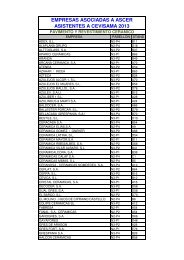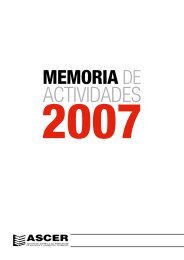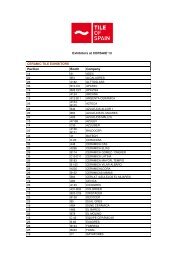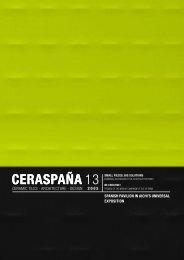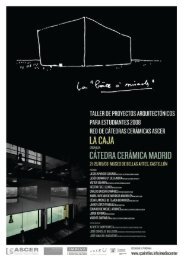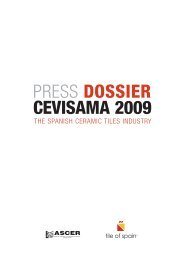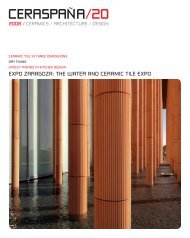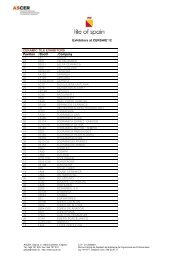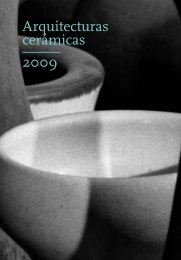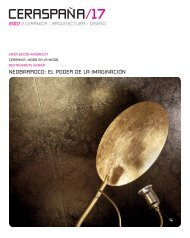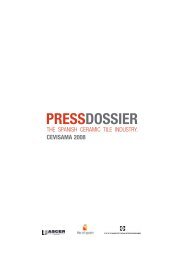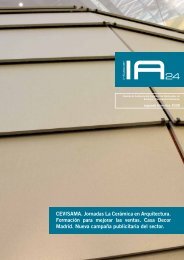You also want an ePaper? Increase the reach of your titles
YUMPU automatically turns print PDFs into web optimized ePapers that Google loves.
shows the versatility, flexibility and considerable potential <strong>of</strong> the materialsused. The arch itself is a clear example <strong>of</strong> how important ceramic tiles arein the field <strong>of</strong> construction and, given that at its thinnest point the arch isjust 65 millimetres thick, <strong>of</strong> their strength and malleability as well.All <strong>of</strong> these features must make the Four Saddles Arch <strong>of</strong> Lily <strong>of</strong> the ValleyArch one <strong>of</strong> Ebetsu’s most emblematic monuments. It is certainlyphotographed and remembered by all those who visit it. Tanaka himself hasdefined it as “original, innovative and extraordinary, with a geometricarchitectural symbolism.”The impact <strong>of</strong> this work, which is unique in Japan, has reached far beyondthe Asian country’s frontiers, making it a point <strong>of</strong> reference in both art andceramic architecture. In <strong>Spain</strong>, the Asociación Gaudí & Barcelona Club, <strong>of</strong>which Hiroya Tanaka is also a member, promotes this unusual “saddle” asan example <strong>of</strong> Antoni Gaudí’s universality and the relevance <strong>of</strong> his worktoday.Hiroya Tanaka owes his adopted Catalan status to his devotion to theCatalan genius and to the studies <strong>of</strong> modernism’s most celebratedmastermind that he carried out in <strong>Spain</strong>. In 1992 he worked on a thesistitled “Graphic Methodology: Drawings and Proportion in the Work <strong>of</strong> Gaudí”,which he defended at the Polytechnic University <strong>of</strong> Catalonia in 1992 andwhich earned him a doctorate.Tanaka is one <strong>of</strong> the world’s most knowledgeable people on Gaudianarchitecture. The Japanese expert is one <strong>of</strong> the leading researchers into thework <strong>of</strong> Gaudí and has participated in technical conferences for architects in<strong>Spain</strong>, giving papers such as “Measurements and Proportion in the work <strong>of</strong>Gaudí”, which he presented to an audience <strong>of</strong> students and pr<strong>of</strong>essionals inBarcelona.He has also given talks and masterclasses on his visits to Catalonia, at theCasa de Asia (Asia House) in Barcelona, where in sessions such as the onetitled “Architecture, Gaudí and Me” the audience learned from the Japanesemaster himself about his link with Antoni Gaudí.Hiroya Tanaka considers that the beauty <strong>of</strong> the work <strong>of</strong> the famous Catalanmaster, who died in 1926, lies in the technique and proportions he used,which are “directly related to nature and its beauty”.Hiroya Tanaka’s CV is long and dazzling: he took his first degree at the University <strong>of</strong> Kokushikan, holds a Doctorate in Architecturefrom the Advanced School <strong>of</strong> Architecture in Barcelona, part <strong>of</strong> the Polytechnic University <strong>of</strong> Catalonia, and has studied the work <strong>of</strong> AntonioGaudí extensively.His many merits include having founded the Gaudí Club and he is also known for being the designer <strong>of</strong> the Gaudí Objects Collection,in which he has kept the mathematical proportions set by the Catalan genius – and that elevated him to the very pinnacle <strong>of</strong> hispr<strong>of</strong>ession – down to the last millimetre. He has even suggested Gaudí be canonized for having reflected his fervent religionsconvictions in his calculations. The objects that Hiroya Tanaka has designed include, amongst other things, liqueur bottles for suchprestigious brands as Torres (Gaudí Brandy), whose lines pay homage to the famous man and to the spirit <strong>of</strong> innovation <strong>of</strong> all thosewho, in whatever pr<strong>of</strong>ession, passed the excitement <strong>of</strong> work well done down from father to son.The architect has also written several books including “Gaudí’s Architecture. A collection <strong>of</strong> drawings <strong>of</strong> construction in progress”, “Gaudíand restraint” and “Graphic Methodology, drawings and proportion in the work <strong>of</strong> Gaudí”, published by the university <strong>of</strong> Shokokusha andthe Polytechnic University <strong>of</strong> Catalonia.CERASPAÑA17



